Medical Cardiology
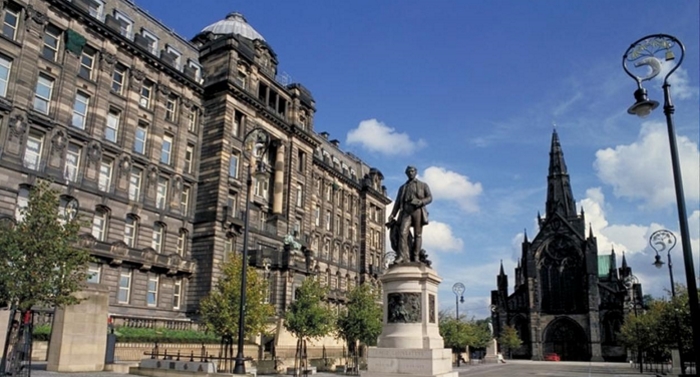
During the 1950s, the senior cardiologist in Glasgow Royal Infirmary (GRI) was Dr Joseph Wright. He directed a team studying 400 patients with rheumatic mitral valve disease and 100 with congenital heart disease, and collaborated with the Professor of Surgery, William Arthur Mackey in the development of open-heart surgery for such patients. As president of the Royal Faculty of Physicians and Surgeons of Glasgow (1960-62), Dr Wright also achieved the Faculty's promotion to Royal College, to rank alongside sister Colleges in Edinburgh and London (find out more).
A privately endowed chair was established to mark Dr. Wright's retiral. Thus, the University Department of Medical Cardiology was formed in 1966 when the family of Isidore Walton from Glasgow donated a large sum of money from their family Charitable Trust to the British Heart Foundation to endow the Walton Chair of Medical Cardiology. The first incumbent to the chair was Professor T D V Lawrie and the earliest members of staff included Prof. A Ross Lorimer, Dr. David McCall and Prof. Peter Macfarlane. Dr Ian Hutton joined the Department in 1974.
The department was initially located in Ward 7 of Glasgow Royal Infirmary, although the investigative facilities and research laboratory were elsewhere on site. Professor Lawrie developed Ward 7 into a Coronary Care Unit, and Ross Lorimer and Dr John Kennedy set up coronary angiography in the late 1960s. Cardiac pacemaker insertion was also undertaken. The department was a major contributor to the landmark European Study on the benefits of coronary bypass surgery. Professor Philip Caves and Mr W Bain of the University Department of Cardiac Surgery were also heavily involved.
Joe Wright's chauffeur by Stuart McAlpine (house officer)
"He didn’t drive, so I became his chauffeur. I found I was working seven days a week, taking him to GRI and back; seeing his private patients in Canniesburn. On Sundays I drove him to domiciliary visits – Girvan, Lanark, Helensburgh. I remember getting £5 for this on Sundays. One day by mistake he gave me a £20 note. I looked at it and told him so he hastily took it back!"
In the 1970s, Ian Hutton developed new techniques using radio-isotopes to assess myocardial perfusion non-invasively and thus differentiate cardiac from non-cardiac chest pain. What began as a research project led to the creation of the Department of Nuclear Cardiology, which provided a regional service to the West of Scotland and beyond.
A new development in the late 1970s was percutaneous coronary intervention – angioplasty – using intracoronary balloons and later metallic stents to open obstructed coronary arteries and restore normal blood flow. This technique is now a definitive treatment for angina and developing acute myocardial infarction.
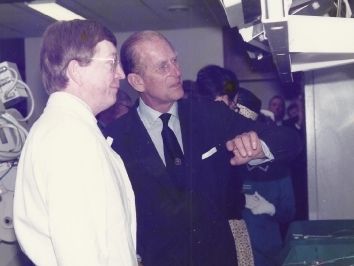
When the Queen Elizabeth Buildings were opened at GRI in 1983, the Department moved to level 4 of the “University Tower” where there was one cardiac catheterisation laboratory and 16 beds available. The University Department of Cardiac Surgery was on the same level ensuring close cooperation between cardiologists and cardiac surgeons. A second catheter laboratory operated in the theatre suite.
Atherosclerosis
Veitch Lawrie had a major interest in the role of cholesterol in the genesis of atherosclerosis. Through support from the British Heart Foundation, the Walton Trust and the Fraser Foundation, Professor Lawrie established laboratories to further his research into the composition of the atheromatous plaque. His work was complemented through collaboration with the academic Clinical Biochemistry Department in order to expand further the role of lipids in the pathogenesis of coronary heart disease. This laid the foundation for further research in lipidology as described elsewhere.
Automated ECG analysis
Work on computer analysis of electrocardiograms was initiated in the mid-1960s by Veitch Lawrie who supported Peter Macfarlane in developing the technique, work which the latter continued for over 50 years to the present day, with the University of Glasgow ECG analysis software being used worldwide by many commercial companies. The London Ambulance service, for example, in 2016 had over 700 Lifepak 15 defibrillators, produced by Physio Control in Seattle, for use in ambulances and each has the University of Glasgow ECG analysis program inside.
Clinical Trials
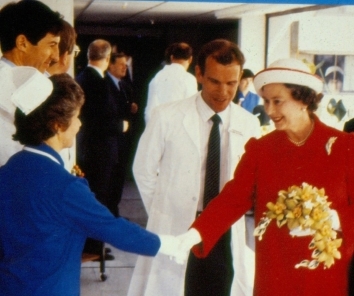
In 1985, Professor Stuart Cobbe became the second Walton Professor of Medical Cardiology and continued in this post until 2008. In 1988, Professor James Shepherd (Pathological Biochemistry) and Professor Cobbe initiated the West of Scotland Coronary Prevention Study (WOSCOPS).
This landmark trial, published in 1995, proved the benefits of lipid lowering by statins in the primary prevention of coronary artery disease.
Professors Shepherd and Cobbe were Co-principal Investigators of this study, while all 30,000 ECGs recorded over six years were handled by the automated ECG facilities in the department under Peter Macfarlane.
Arrhythmia Services
Professor Cobbe’s other major interest was in cardiac electrophysiology and arrhythmias, and he developed an arrhythmia service along with Andrew Rankin who became Professor of Medical Cardiology in 2006. Dr Alan Rae (NHS) also made a major contribution to this service. Professors Cobbe and Rankin had interests in basic science and established research programmes, in collaboration with life scientists, to study mechanisms underlying cardiac arrhythmias. Stuart Cobbe also established the Heartstart Scotland programme, with the enthusiastic cooperation of the Scottish Ambulance Service. The service was the first in the world to be equipped with automated external defibrillators in all front-line ambulances. The outcome of pre-hospital use of defibrillators was logged in what became the biggest pre-hospital cardiac arrest database in the world.
Centralisation
The construction of the British Heart Foundation Glasgow Cardiovascular Research Centre led to the transfer of Professors Cobbe and Rankin’s basic science research groups to the University campus. When Professor Cobbe retired in 2008, the University decided not to replace the Chair of Medical Cardiology and Cardiology was integrated with the School (later the Institute) of Cardiovascular and Medical Sciences.
Professor Peter Macfarlane, Doctor Ian Hutton and Professor Stuart Cobbe
Images provided by authors
Cardiac Surgery
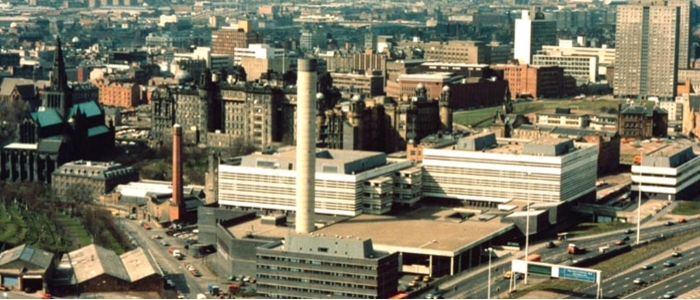
In the years immediately following the second world war, virtually all procedures affecting the heart and great vessels (coarctation repair, closure of patent ductus, arterio-pulmonary shunts, “closed” mitral valvotomy) were undertaken by thoracic surgeons with an interest in the heart. Cardiac surgery came into being as a separate specialty following the successful use of the heart lung bypass machine in the early 1950s which made surgical procedures on or inside the immobilised heart feasible.
The University Department of Cardiac Surgery soon became active in this newly emerging specialty of heart surgery, developing an international reputation for clinical and research work, contributing to the literature of cardiac surgery and bio-engineering, fostering high standards of clinical work, improving training, and providing academic leaders for the future.
An emerging specialty
William Arthur Mackey, St Mungo Professor of Surgery at the Royal Infirmary, recognising the potential of this emerging specialty, encouraged the young William Bain to continue his interest in heart surgery and the heart lung bypass machine, kindled by a training period in the USA. During the 1950s, as lecturer, senior lecturer, reader (and later Professor) William Bain began an extensive practice in cardiac surgery, initially in Ward 49, moving to Ward 30 in 1975, mainly focusing on valve replacement surgery. His lecturer, Ken Taylor, undertook experimental work during the 1970s on the effect of pulsatile and non-pulsatile blood flow on the pituitary-adrenal axis during extra-corporeal circulation. Ken Taylor was later to move to the Hammersmith Hospital as Professor of Cardiac Surgery.
In 1974, a Chair of Cardiac Surgery was established with the generous support of the British Heart Foundation and the Isidore and David Walton Foundation. The first holder of this post was Professor Philip Caves who had distinguished himself during a training secondment to the leading heart transplant centre in the world at Stanford University, USA, under the direction of Norman Shumway. While there, Philip Caves developed the instrumentation and technique for biopsy of the right ventricle for the rapid histological diagnosis of acute rejection in transplant patients. This was a major advance in management that has remained the gold standard for rejection diagnosis. Tragically, Philip Caves died prematurely in 1978, leaving his two senior registrars, Peter Goldstraw and John Wallwark, to enhance the reputation of the Glasgow centre by going on to become internationally recognised leaders and Professors in Thoracic Surgery at the Brompton Hospital in London, and Cardiac and Pulmonary Transplantation at Papworth Hospital near Cambridge, respectively.
In 1979, David Wheatley was appointed to the Chair of Cardiac Surgery, a post he held until his retirement in 2006. It seemed apparent that, in 1979, Glasgow was not filling the pressing clinical need for surgery for coronary artery disease, a particularly prevalent problem in the West of Scotland. An early policy decision was therefore implemented to persuade all the cardiac surgeons in Glasgow to come together under the umbrella of “Glasgow Cardiac Surgery” to provide a unified training environment, to unify and enhance clinical practice, and to benefit from the exchange of ideas.
William Bain took on the role of leadership at the Western Infirmary, and the University granted him a personal chair. He was closely involved with addressing an international problem besetting a popular version of the Bjork-Shiley artificial heart valve that proved vulnerable to catastrophic, and usually lethal, valve failure. Professor Bain worked with the Shiley Company to identify patients at maximal risk, and also devised a method of predicting the failure in time for replacement surgery. Geoff Berg, in the Western Infirmary group, developed the concept of “near miss” episodes in surgery, rather than just reporting fatal outcomes or severe complications. This work contributed greatly to general improvement in the standards of cardiac surgical practice throughout Glasgow and attracted national interest.
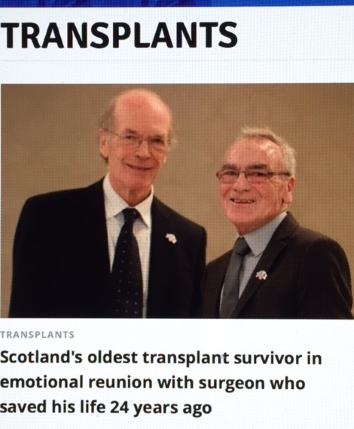
It was deemed wise not to pursue cardiac transplantation (a natural ambition for Philip Caves) at that stage, and it was to be another decade later that surgical numbers had increased sufficiently to meet clinical needs and to better justify heart transplantation.
The reputation of Philip Caves opened the door to a highly productive relationship with Norman Shumway for the Glasgow Department, and Scotland's first heart transplant was undertaken on 1st January 1992 in an appropriately designed unit within the Royal Infirmary by David Richens (read more).
In 1980, David Wheatley and his anaesthetic and cardiology colleagues, Professor Donald Campbell and Professor Veitch Lawrie, made a visit to Cairo which was to signal the start of a long and productive relationship with Ain Shams University and Professor Ismail Sallam, who had trained with William Bain in Glasgow.
Professor Sallam went on to become Egyptian Minister of Health. He continued to send his trainees to Glasgow and David Wheatley made annual visits to Cairo to demonstrate surgical techniques and train young surgeons.
Among the department's lecturers and trainees in the clinical and research fields were David Taggart, who went on to become Professor of Cardiac Surgery in Oxford and an international figure in coronary bypass surgery and its role; Tom Spyt, who became Professor of Cardiac Surgery in Leicester; Mohommed El-Fiky, who became Professor of Cardiac Surgery in Cairo; and John Dark, who became Professor and Head of Cardiac and Pulmonary Transplant Surgery in Newcastle.
Artificial Heart Valves
A laboratory was established in 1983 within the Academic Block of the Phase 1 development at Glasgow Royal Infirmary for research into artificial heart valves. The laboratory was equipped with pulse duplicator, fatigue testers, electron microscope and Nd-YAG laser generator, CAD-CAM manufacturing facilities and electrostatic spinning equipment. Gill Bernacca worked over many years co-ordinating the laboratory work and contributing to knowledge in the field of polymeric valves. The Wellcome Surgical Research Institute at Garscube was available for the necessary in vivo evaluations.
Responding to a clinical problem of early failure in a commercial bioprosthetic heart valve, members of the department designed and evaluated a new heart valve that overcame the problem of early failure and saw the new valve (the Bioflo valve) manufactured in Scotland and implanted in patients as part of a randomised clinical trial beginning in February 1987, with performance equalling that of the market-leading control valve. A lecturer in the department, John Fisher, achieved his PhD from work on this valve development, leaving subsequently to take up a position in Leeds where he was to become Professor of Mechanical Engineering.
Margaret Tolland submitted this work to the British Technology Group competition in 1988, for which the award of first prize for design was made. She was also instrumental in achieving an award from the British Medical Association for the best surgical textbook (“Surgery of Coronary Artery Disease”) in 2003, for which she had undertaken much of the photography and had also co-ordinated the surgical texts.
Although the Bioflo valve performed as well as the contemporary leading commercial valve in the randomised trial, it was withdrawn from clinical practice as a precaution during the outbreak of bovine spongiform encephalopathy (“mad cow disease”) in British Cattle in the late 1980s. This stimulated the Department to embark on a search for a suitable synthetic analogue for the pericardial valve. In conjunction with Professor David Williams of Liverpool University, Professor John Fisher of Leeds University, and a commercial partner, Aortech Ltd, a Medlink-funded project to design and test a polymeric flexible leaflet heart valve was undertaken. 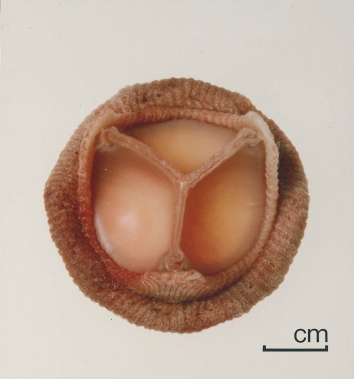
The valve was manufactured by Aortech Ltd in the West of Scotland and further clinical application was pursued by Aortech in the USA.
Research and Education
On a national scale, as President of the Society of Cardiothoracic Surgeons of Great Britain and Ireland (1997-1999), David Wheatley took a leading role in promoting personal surgical outcome reporting for all cardiac surgeons in the UK. As Chairman of the Intercollegiate Examination Board for Cardiothoracic Surgery, he introduced the post-graduate examination for Cardiothoracic surgical trainees.
On an international scale, the UK was represented by him as a founder council member of the European Association for Cardiothoracic Surgery in 1986, taking a particular interest in Continuing Medical Education as CME Editor for the European Journal of Cardiothoracic Surgery, and also taking a leading role in establishing the European Cardiothoracic Surgical Examination.
During his European Presidential year in 1999, Glasgow hosted the European Association for Cardiothoracic Surgery that attracted some 5,000 delegates from around the World. This highly successful meeting, planned by Margaret Tolland, highlighted the attractions of the West of Scotland, culminating in a concert at the Glasgow Royal Concert Hall with the Royal Scottish National Orchestra (“Scotland in Music, Poetry and Song”) and provided a fitting tribute to her long and devoted work with both Professor Caves and Professor Wheatley, as well as the work of the Department of Cardiac Surgery and the many other University departments with which productive research efforts had been forged.
Following Professor Wheatley’s retiral in 2006, the Chair was suspended.
Professor David J Wheatley
Images provided by Professor Wheatley, who obtained permission from the heart transplant survivor to publish this image
Cardiology and Cardiac Surgery in Children
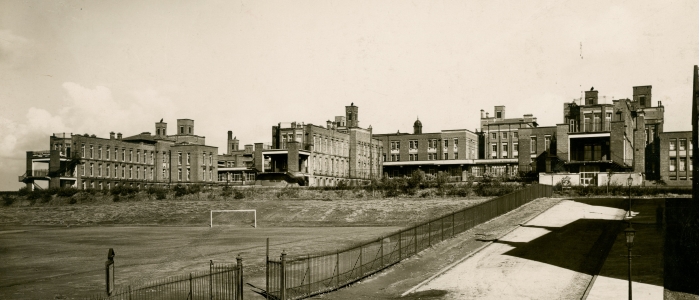
Cardiac physicians and surgeons work very closely together in the investigation and management of children with heart disease. In 2011, this resulted in the establishment of the Scottish Paediatric Cardiac Service in the Royal Hospital for Children, Glasgow. This review deals with both medical and surgical aspects.
Early Days
Before the days of heart lung bypass machines, closed heart surgery allowed the correction of relatively simple lesions, such as ligation of patent ductus arteriosus (PDA) (1938) and repair of coarctation of the aorta (1944). Sir John Fraser in Edinburgh is reported to have closed the first PDA in Scotland (1940) and was the second surgeon in UK to perform this operation. The Blalock-Taussig shunt allowed palliation of certain cyanotic heart lesions such as Tetralogy of Fallot (1944). Open heart surgery was undertaken with human cross-circulation (1955) and then extracorporeal bypass circuit (1955).
Open Heart Surgery
In Glasgow, surgery for heart disease was initiated in the Royal Infirmary by Professor William Arthur Mackey (see Cardiac Surgery). Mr William (Bill) Bain (later Professor) travelled to the United States as a Fulbright scholar to learn and bring back the skills and technology required for successful open heart surgery. The first open heart patient had a primum atrial septal defect (ASD) corrected in 1959. Twenty five years later she underwent mitral valve replacement by Mr James Pollock, and several years later implantation of a trans-venous pacemaker.
Congenital abnormalities and cancer are, perhaps fields in which we are especially helpless but slowly even these things are being conquered
In 1951, Dr James Holmes Hutchison, subsequently Professor of Child Health, (see Child Health) wrote to the parents of an infant who had died before treatment was available saying “Congenital abnormalities and cancer are, perhaps, fields in which we are especially helpless but slowly even these things are being conquered”. By the 1950s, it had become apparent that paediatric cardiology skills were necessary for the Royal Hospital for Sick Children (RHSC), Yorkhill, Glasgow. Professor Stanley Graham (see Child Health) arranged for Eric Coleman who was then a junior hospital medical officer, to go to the Karolinska University Hospital in Stockholm to learn the skills required.
In 1961, he was appointed consultant with particular interest in cardiology. At this time, diagnosis moved from clinical examination with ECG and X-ray to more sophisticated imaging using cardiac catheterisation. This was started in the X-ray Department with radiologist Philip Rawson. Special goggles were needed to view the images: there was only one pair, and since Dr Rawson was more senior, he had first call on them. Dr Coleman recalled he was too junior to complain!
In the 1960s, the question of cooperation between children’s and adult cardiac units in the city was raised. Dr Joseph Wright (see Cardiology) wanted a single unit to be based at the Royal Infirmary. A meeting was called to discuss this; Dr Coleman could not attend and Professor Hutchison represented paediatric cardiology. At the end he stated “You do not want our co-operation – you want our patients!”
Paediatric cardiac services remained at the RHSC. When Yorkhill hospital was demolished, services moved temporarily to Oakbank Hospital; children were admitted there for assessment and transferred to Mearnskirk Hospital for catheterisation and subsequent surgery. Mearnskirk was a tuberculosis hospital and a new cardiac theatre and wards were opened in 1971, under the supervision of Mr Robert (Bob) Barclay. He, Norrie McSwan and Tom Welsh were chest surgeons who added congenital heart surgery to their skills (read more).
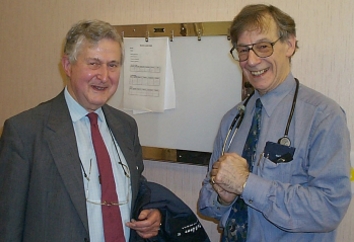
Another physician with expertise in cardiology was needed, and William (Bill) Doig was appointed in 1972. He became a much loved and favourite doctor with the families and the children. He had such rapport with the children that in his early years they called him “Doctor Yogi”.
When in 1965 the decision was made to rebuild the Children’s Hospital at Yorkhill, the medical superintendent, Hugh Park, was adamant that cardiac surgery should also be carried out there. The new hospital had a modern cardiac investigation department and catheter laboratory under the supervision of Lilian Murray. Balloon atrial septostomy for Transposition of the Great Arteries (TGA) was then possible and performed by Drs Coleman and Doig. Surgery in the new Yorkhill Hospital was initially performed by the Mearnskirk team, with the assistance of John Bentley, the general surgeon who had undertaken cardiac work when training in London.
Intensive Treatment Unit (ITU) cover was sparse, with consultant cover from on-call anaesthetists and cardiologists, and junior staff support from on-call medical registrars .
Phillip Caves was appointed as Professor of Cardiac Surgery in 1975 (see more in Cardiac Surgery). He had been a clinical fellow in Stanford University under Norman Shumway, and had particular interest in congenital heart surgery. He introduced new techniques of operation, improved post-operative ITU care and so increased survival rates. On a visit to Stanford he had seen the value of ultrasound. There was an early real-time 2-dimensional imaging system in use in the RHSC, developed by the Clinical Physics Department as a result of the pioneering work by Professor Iain Donald who had put the use of ultrasound into clinical practice. Philip greatly supported Dr Alan Houston going to train in Toronto, where he was warmly welcomed because of the work he had published on the use of the 2-D scanner. Houston later became involved in other aspects of cardiac ultrasound.
Tragically, Professor Caves died all too prematurely in 1978 and the Chair passed to Professor David Wheatley in 1979. Shortly after he was appointed, his increasing commitments meant that he had less time to spend in paediatric practice and Mr James (Jim) Pollock was appointed as consultant surgeon in 1980. A further surgeon, Mr Morgan Jamieson, started work in 1983. Results of the first 15 years of congenital surgery repairs and techniques were scrutinised. Some procedures had good long term results but some patients, such as those with TGA repaired with the Mustard or Senning procedures, experienced problems in the medium term.
New Techniques
This evaluation led to the development of new techniques and earlier corrective repairs. For babies with TGA, Pollock who trained in Toronto, undertook the Mustard operation while Jamieson, Great Ormond Street trained, preferred the Senning. In 1984, the decision was taken to use the Switch/Jatene procedure. Over the next decade, the trend continued for earlier repair of complex lesions in infancy, with marked improvement in long term results. Kenneth (Ken) MacArthur was appointed as a third cardiac surgeon in 1989. He was to become particularly skilled at infant surgery, and was the first director of the combined medical and surgical Scottish Paediatric Cardiac Service in 2011.
Cardiac ultrasound became an essential diagnostic technique from the late 1970s. It developed from wavy lines reminiscent of a Second World War destroyer chasing a German U-boat, to 3D moving images of the heart in colour.
Alan Houston was appointed medical senior registrar in 1974. He had an interest in cardiology and Eric Coleman told him “You are going to write an MD thesis. Do you have any ideas? How about looking at echocardiography? See if it works? I don’t mind if it doesn’t but we should know about it”.
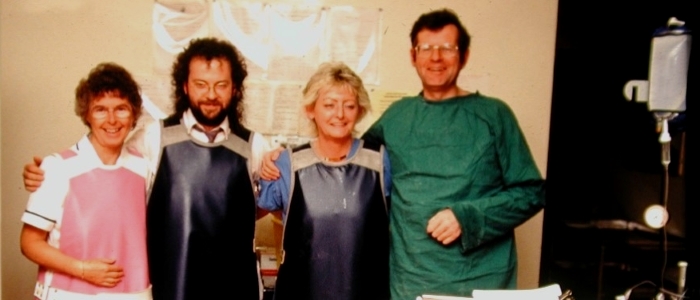
M-mode echocardiography was undertaken in the X-ray department by the radiologist Mamie McNair and radiographer Tish Maclardy. Houston was with them one day when Professor Wheatley, senior registrar at the time, came with a still image from a two-dimensional real-time scanner developed by the Clinical Physics Department. Houston showed immediate interest and thereafter the equipment came to Yorkhill to be used with the X-ray ultrasound machine - but he could only do so before 9 am or after 5 pm! When it was clear that the equipment was promising, a full scanning system was introduced to the Cardiology Department and original papers on Normal 2D Views and the Diagnosis of TGA were published.
Cardiac physiologists Eamon Murtagh and Stuart Lilley (SL) undertook the ultrasound studies for the year Houston was training in Canada (1978-1979).
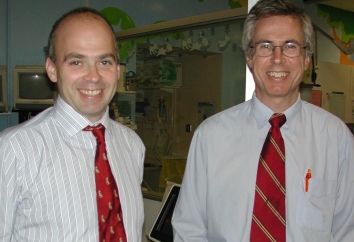
When he returned, they said “We suppose you will want to do all the echoes yourself” to which he replied “No, we will work together”. Their involvement continued and increased as they participated in development work and training with the ultrasound company, Vingmed, later taken over by General Electric.
The ultrasound department has prospered since then. Early work was done with stand-alone Doppler, and the UK’s first Vingmed colour Doppler scanner was purchased in 1987. Further original work was achieved and published, much of it due to the efforts of James Gnanapragasam, research fellow. Transoesophageal and three-dimensional equipment were introduced in 1989 and 2005 respectively.
Houston brought in the use of prostaglandin to maintain patency of the new-born arterial duct after he returned from training in Canada in 1979. He was appointed consultant in 1983. When Coleman retired in 1990, Neil Wilson was appointed consultant cardiologist. He had a major interest in interventional catheterisation. He undertook the world’s first ASD closure by the Helix device (1999), and rotational assisted angioplasty of an obstructed aorto-pulmonary collateral artery in a child (1998). His work led to the development of combined medical / surgical hybrid procedures for complex lesions.
He could entertain with juggling and sleight of hand magic, and was a keen humourist with colleagues and patients. Intraoperative evaluation of surgical repairs with epicardial or transoesophageal ultrasound, at which Stuart Lilley became particularly skilled, became routine and resulted in improved outcomes. By the end of the century, successful repair techniques for most congenital lesions had been developed and deployed in the West of Scotland.
World’s first ECMO ablation 1996
The first pacemaker implant in the RHSC had been undertaken in 1975. As senior registrar, Karen Mcleod developed an interest in electrophysiology and undertook, in 1996, the world’s first ablation procedure in a patient on an extra corporeal membrane oxygenator (ECMO) in 1996. She continued to develop the techniques after being appointed as consultant (1999), making ablation procedures, mapping and the implantation of the implantable cardiac defibrillator (ICD) a routine service. ECMO was introduced from 1992, largely due to the enthusiasm of Carl Davis, general paediatric surgeon, who had gone to the USA to train in the use of this technique (see Child Health).
Data collection was vitally important for the evaluation of outcomes. Eric Coleman introduced a punch card system in the 1950s and this continued in use until superseded by the computer system, Heartsuite. The system which was to become Heartsuite was developed by Robert Fraser, cardiac physiologist, working with Alan Houston. With concern for the potential effect of the “Millennium Bug”, Robert gave the system to Alasdair MacBain in 1996 and moved to management. The system was subsequently introduced to many other congenital cardiac centres in the UK, and was important for the national audit system after the Bristol Royal Infirmary Inquiry into cardiac surgical results.
As a result of the Bristol Inquiry, the Scottish Government carried out an extensive review of its two paediatric cardiac surgical services, in Glasgow and Edinburgh. The final result was the decision to centralise paediatric surgical services in Glasgow. The Edinburgh medical consultants, Janet Burns and Mohammad Walayat, joined the Glasgow team, working in both centres. The Scottish Paediatric Cardiac Service was formally set up in 2011, with Ken McArthur as its first director. The twenty first century saw sub-specialisation become important. In interventional cardiology, Trevor Richens (2003) replaced Neil Wilson, and Brodie Knight was appointed in 2004.
Trevor was the first in Scotland to undertake the medical/surgical hybrid procedure with surgical consultant Mark Danton (2006) and trans-catheter pulmonary valve replacement and Brodie undertook the first in the UK per-ventricular closure of a ventricular septal defect (2004).
On the surgical side, Mark Danton replaced Morgan Jamieson in 2002 and Andrew (Chuck) Maclean was appointed in 2007. Mark was instrumental in bringing the Norwood Stage I procedure to RHSC in 2011. He had a major role in supervising students through to successful MD and PhD degrees and became Visiting Professor in the Bioengineering Unit, University of Strathclyde in 2013.
The ITU consultants had all been anaesthetists until Andrew Macintyre became the first paediatrician intensivist (critical care) in 1994. Thereafter there was a transition to full-time paediatric intensivists as the anaesthetist intensivists retired. All ITU consultants were trained paediatric intensivists by 2017.
Telemedicine was developed by Alan Houston and Robert Carachi, Professor of Surgery, its first use being for the transmission of echocardiographic images. It was initially the National Paediatric Video Conferencing Network but subsequently became part of the Scottish Centre for Telehealth & Telecare.
Alan Houston retired in 2011 to be replaced by Benjamin (Ben) Smith whose speciality was interventional procedures. Subsequent appointments were Maria Ilena (electrophysiology and echocardiography, 2012), Patrick Noonan (interventional procedures, 2013), Lindsey Hunter (fetal cardiology, 2014) and Nanda Prabhu (cross-sectional imaging, 2018). Edward (Ed) Peng was appointed as a consultant surgeon in 2015.
With the move of the RSHC to the new Royal Hospital for Children on the former Southern General Hospital site in 2015, the paediatric cardiology service entered a new custom built unit. By this time, there were more adults than children alive with congenital heart disease: increasing numbers with complex lesions were now surviving into adulthood and thus forming a new patient group with their own unique problems.
A specialist medical service for adult congenital heart disease had initially been provided by Drs Ralph Thomson and Morton Fyfe, and was further developed by Professor Stewart Hillis. When he retired, Hamish Walker took over (2007 to 2014) then subsequently Nicky Walker (2010), Colum Owens (2011 to 2013) and Ines Uribe-Morales (2016).
When possible, surgery on adults was undertaken by the same surgeons who had operated on them as children. The input of the adult congenital specialists was, and continues to be, essential for the continued well-being of many of those treated as children.
“The Development of Paediatric Cardiac Services in Scotland” - provides further details of developments across Scotland (Richens T; Scottish Medical Journal 2006, 51, Issue 2)
Dr Alan Houston and Mr James Pollock
Images provided by authors

